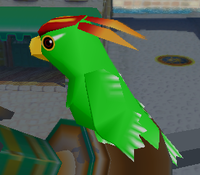Bird (Super Mario Sunshine)
- This article is about the species from Super Mario Sunshine. For other uses, see Bird.

The Birds[1] are a species of multicolored parrot-like tropical birds that live on Isle Delfino in Super Mario Sunshine. Each colored bird gives out a special reward to Mario if he sprays it with FLUDD. Additionally, a Yoshi can eat one or spray one with juice. The Isle Delfino Birds fly away at the sight of Mario and are usually perched in high places.
Types of BirdsEdit
Green BirdEdit
Green Birds[1] are the most common type of bird and appear in almost every open area of Isle Delfino. If Mario sprays them with FLUDD or juice, they drop a coin.
Blue BirdEdit
Blue Birds[1] are the second-most common type of bird and appear in almost every open area of Isle Delfino but in lower quantities than Green Birds. If Mario sprays Blue Birds with FLUDD or juice, they drop a blue coin.
Gold BirdEdit
Gold Birds[1] are a rare type of Isle Delfino bird. In fact, only two appear on the whole island: one in Delfino Plaza, and another in Noki Bay, in the secret mission A Golden Bird. If Mario sprays them with FLUDD or juice, they turn into a Shine Sprite.
Three other Gold Birds are shown flying around the Shine Gate during the game's ending.
Red BirdEdit
Red Birds[1] are the rarest of all the Isle Delfino birds, with only one in a secret level in Delfino Plaza. In fact, Red Birds are so rare that a Pianta ornithologist in this level claims to have been tracking the sole "red bird of happiness" for 38 years. If Mario sprays it with FLUDD, it drops a red coin.
GalleryEdit
Names in other languagesEdit
| Language | Name | Meaning |
|---|---|---|
| Japanese | 鳥[2] Tori |
Bird |
